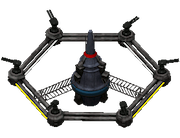Military Outpost Update
Posted by SparkleSep 19
 On the day of the 10th anniversary of Pardus, some much anticipated updates to the Military Outpost finally arrived.
On the day of the 10th anniversary of Pardus, some much anticipated updates to the Military Outpost finally arrived.
A full explanation is included in the Pardus Manual, but I wanted to summarise some of the main points here.
Hospitaility to Young Pilots
According to the Pardus In Game News where the Military Outpost update was initially announced:
…new players sometimes had a hard time to explore the universe due to the ever-increasing rigidity and fragmentation of territories…
Military Outpost owners now have the ability to allow pilots who are under newbie protection (those that have played less than 50,000 action points) to pass through the Military Outpost – regardless of whether they would normally be allowed to. This option is enabled by default and is able to be configured via the Pass Settings option for the Military Outpost.
If you have a Military Outpost and you do not want to grant passage to pilots under newbie protection, don’t forget to change your Pass settings disable passage for them by removing the checkbox beside the option “Allow passage to pilots new to space” (and don’t forget to them press the “Save” button).
Surveillance Settings
With the introduction of a Surveillance Grid, there is now a chance that pilots can pass a blocking Military Outpost – even though previously they would not have been granted passage.
All ship types have been grouped into one of three categories to reflect their ship signature (clear, average, faint) and that signature is used to determine the chance of passing through a (normally blocking) Military Outpost.
The higher you set the value of the Detection Grid Strength (via a sliding control on the Pass Settings screen) the lower the chance a ship is granted passage (if they would normally be blocked) and the more upkeep your Military Outpost will consume per tick.
If you leave the Detection Grid Strength at zero, your Military Outpost will use the same upkeep as it always has (5t Fuel and 5t Energy) per tick. This setting will allow ships (that are normally blocked) with a clear signature to be blocked 75% of the time (so they have a 25% chance to pass), those with an average signature will be blocked 25% of the time and those with a faint signature will not be blocked at all.
If you set the Detection Grid Strength to the maximum value of 20, your Military Outpost upkeep changes to require 15t Fuel, 15t Energy and 15t Radiation Cells per tick. This setting will block all ships (regardless of their signature) 100% of the time.
The optimal setting (considering the upkeep cost versus the threat level from ships) for the Detection Grid Strength is value 15 requiring 15t Fuel, 15t Energy and 5t Radiation Cells per tick for upkeep. This prevents passage for ships with a clear and average signature 100% of the time whilst preventing passage for ships with a faint signature 75% of the time.
Crime Level
The chance to block a ship is further modified based on the crime level for the cluster. Low Crime level increases the chance of blocking a ship by 10% whilst High Crime level reduces the chance by 5% and Critical Crime level reduces it by 10%.
Some Examples
A Military Outpost in a Low Crime level cluster:
| Detection Grid Strength | Blocks Clear Signature | Blocks Average Signature | Blocks Faint Signature |
|---|---|---|---|
| 0 | 85% | 35% | 10% |
| 3 | 100% | 50% | 25% |
| 13 | 100% | 100% | 75% |
| 15 | 100% | 100% | 85% |
| 18 | 100% | 100% | 100% |
A Military Outpost in a Medium Crime level cluster:
| Detection Grid Strength | Blocks Clear Signature | Blocks Average Signature | Blocks Faint Signature |
|---|---|---|---|
| 0 | 75% | 25% | 0% |
| 5 | 100% | 50% | 25% |
| 15 | 100% | 100% | 75% |
| 20 | 100% | 100% | 100% |
A Military Outpost in a High Crime level cluster:
| Detection Grid Strength | Blocks Clear Signature | Blocks Average Signature | Blocks Faint Signature |
|---|---|---|---|
| 0 | 70% | 20% | 0% |
| 5 | 95% | 45% | 20% |
| 15 | 95% | 95% | 70% |
| 20 | 95% | 95% | 95% |
A Military Outpost in a Critical Crime level cluster:
| Detection Grid Strength | Blocks Clear Signature | Blocks Average Signature | Blocks Faint Signature |
|---|---|---|---|
| 0 | 65% | 15% | 0% |
| 5 | 90% | 40% | 15% |
| 15 | 90% | 90% | 65% |
| 20 | 90% | 90% | 90% |
From the tables above it is obvious that the Crime Level in a cluster is now something that military planners need to take into consideration when planning defences.
No comments